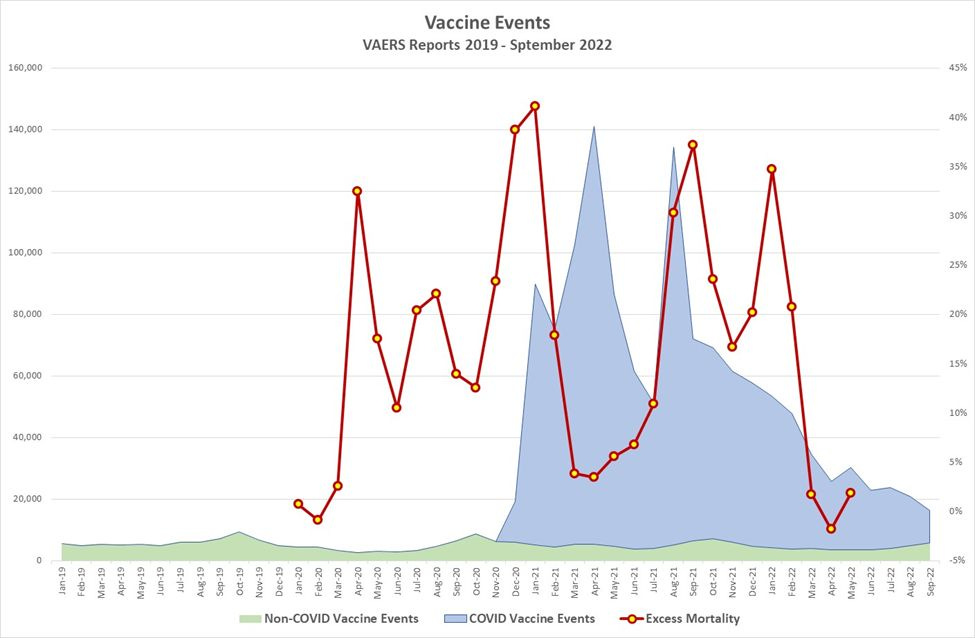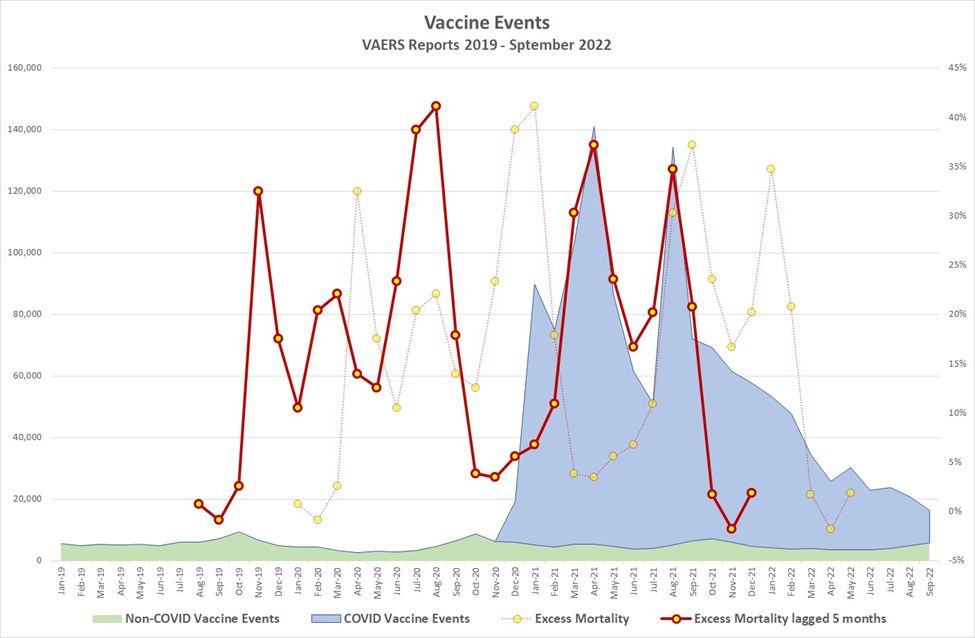Is sudden death more likely 5 months after the vax?
And what about that CDC vote to shoot up school children with the vax?
Peaks in excess mortality lag peaks in VAERS reports of “adverse effects” by five months. Is there a connection? Hold that thought.
On October 20, the CDC’s Advisory Committee on Immunization Practices (ACIP) voted 15-0 to recommend that states require school kids to get the vax. The Committee did this notwithstanding the fact that the CDC’s “surveillance program,” the “Vaccine Adverse Effects Reporting System” (VAERS), has been doing what it was intended to do: Send vivid signals if and when something nefarious was going on with a “vaccine.”
Alas, what is more shocking: the fact that the ACIP voted 15-0 in favor of imposing the vax on school kids or the fact that we expected the ACIP to vote 15-0 in favor of imposing the vax on school kids?
The vote was part of a more elaborate “October 2022 ACIP Meeting.” The CDC posted a “Notice of meeting and request for comment” on September 19. This was all part of standard administrative process.
By 11:59 pm on October 17, the CDC had registered a single comment. By the time comments closed three days later, the CDC had registered 127,438 comments.
Now. Is 127,438 a big number, and does a sizable volume of public comments make a difference in the world? Or does commenting on government initiatives amount to little more than blowing off steam?
I will suggest that 127,438 is an impressively large number and that it does make a difference. Insiders notice, and outsiders (news commentators) are more likely to make a big deal about it. Attracting notice on the inside amounts to alerting insiders to the fact that the public is catching on and that ordinarily sleepy processes like ACIP meetings may remain newsworthy items going forward. Attracting notice on the outside helps create a political issue where, really, there shouldn’t have been one had adults been managing the ACIP process.
Are 127,438 comments a lot of comments?
Let me first take up the matter of the volume of comments.
My experience as an insider (in the antitrust business) and as an outsider who has closely examined “rulemaking processes” over at the Department of Energy (DOE) tells me that 127,438 is a big number. For example, the “energy efficiency program” over at the DOE generates an impressive volume of rulemaking activity. The DOE has subsumed everything from air-conditioners to toasters to lithium battery chargers to electric toothbrushes within a sclerotic mess of energy efficiency regulation, Because Climate Change™.
In 2017, through the course of just a few rulemaking processes, the Trump administration started to tap the brakes on the program. That inspired a torrent of commentary from the public, nearly all of it in the spirit of “Make Appliances Great Again.” In a given year, the program might attract 2,000 comments. But, in the first year of the Trump administration, comments spiked to nearly 46,000. That was a big number.
Meanwhile, I pulled up data from the last year on notices of ACIP meetings at the CDC. I found 11 instances of ACIP activity relating to 11 different docket numbers. The median number of comments by docket was 68. The minimum was 1 and, of course, the maximum was 127,438.
So, 127 thousand is not 127 million, but it does amount (I would suggest) to a vivid signal that something nefarious is going on. Which, of course, inspires us to do what ACIP neglected to do: contemplate the most visit signal of all:
This graph features the monthly count of VAERS reports (from January 2016 through September 2022) and the monthly count of “vaccine” doses (from December 2020 to September 2022).
Note the seasonality of vaccine reports before the rollout of the COVID vax. Reports would average about 5,000 per month and would peak in October, just after the new school year will have started. But, after the COVID mRNA therapies rolled out, reports obviously shot up and peaked somewhere in excess of 140,000 in April 2021 … in just the month that the number of administered doses of the vax peaked. Hmm …
Let’s distinguish the COVID vaccines from all other vaccines and break down COVID vaccine doses by age cohorts:
The green area indicates the monthly volume of reported adverse effects from non-COVID vaccines. All the other stuff indicates adverse effects relating to the COVID vaccines by age cohorts.
What do we see? The seasonality of adverse effects relating to non-COVID vaccines persists through the COVID phenomenon. It doesn’t look any different. Meanwhile, one can wonder if that second conspicuous peak in COVID vaccine reports was driven by the vaccinations of younger people. Or, perhaps, it reflects adverse effects experienced during a wave of second doses. Hard to know.
Let’s now pair VAERS reports with excess mortality:
Is there anything to get out of this graph? Note that excess mortality lags COVID vaccine events by five months. To see this more easily, let’s actually lag the red line by five months:
One can’t help but suggest this interpretation: The first three peaks in excess mortality had a lot to do with COVID as well as with the deleterious effects of COVID policies. But the COVID vaccines seem to have had a lot to do with the peaks in excess mortality in September 2021 and January 2022. They match up tightly. Spooky.
The story would be what? VAERS reports rolled in, but it took about five months for the vaccines to induce fatalities. Entirely healthy looking people would just show up at school, at work, at home and then suddenly drop off.
I do not think I am the first person to suggest specifically that there may be a five-month lag between vaccine intake and death. (I think our friends over at The Exposé have posed such a claim.) But, these data certainly are intriguing. And note what a five-month lag would imply. In my last piece, I reported on how the Florida Department of Health had looked for evidence of adverse effects within the first 28 days after vaccination. But, we have all seen abundant reports of athletes and other healthy people, young and old, suddenly dying. The authorities have tried to pass off this phenomenon of sudden death as just that: as “Sudden Adult Death Syndrome”. But, we have all wondered if there might be lagged vaccine effects. The graphs here suggest conclusions that are consistent with just that: The full measure of vaccine-induced death may only peak several months after vaccination.
Homework assignment for the CDC and the Florida Department of Health: Evaluate the prospect of vaccine-induced fatalities over the course of a year. Do they peak at about the five-month mark? And do we really want to force the states to jab school children?
Sources:
I built up the data on excess mortality from CDC data:
https://data.cdc.gov/NCHS/Weekly-Counts-of-Death-by-Jurisdiction-and-Select-/u6jv-9ijr
https://data.cdc.gov/NCHS/Weekly-Counts-of-Deaths-by-Jurisdiction-and-Age/y5bj-9g5w
https://data.cdc.gov/NCHS/Weekly-Provisional-Counts-of-Deaths-by-State-and-S/muzy-jte6
https://data.cdc.gov/NCHS/Provisional-COVID-19-Deaths-by-Week-Sex-and-Age/vsak-wrfu
The vaccination data also come from the CDC:
https://data.cdc.gov/Vaccinations/COVID-19-Vaccinations-in-the-United-States-Jurisdi/unsk-b7fc
The data on comments relating to energy efficiency standards derive from about 21,000 Federal Register filings under the “EERE” program that had been accessible via API at data.gov.
The data on comments relating to ACIP derive from a request I had put in at data.gov.









Thanks for more confirmation of the connection. Like the ACIP comments (mine among them) the signals are not moving the elephant in the room. So very odd. Wonder what they will say if Sen Johnson can get them in a Congressional hearing? They sure don't care about our opinions now.
Steve Kirsch and Joel Smalley have also written about the 5 month vax-death lag